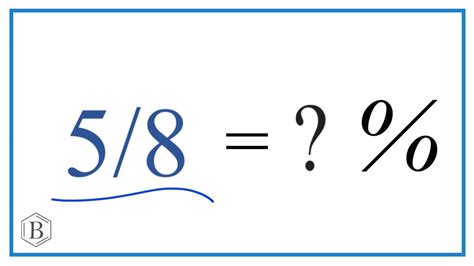What Percent Of 5 Is 8
Kalali
Mar 31, 2025 · 4 min read

Table of Contents
What Percent of 5 is 8? Understanding Percentages and Proportions
The question, "What percent of 5 is 8?" might seem simple at first glance, but it unveils a fundamental concept in mathematics: percentages and proportions. This seemingly straightforward query opens the door to understanding how to solve a wide array of percentage problems, applicable across various fields from finance and business to everyday life calculations. This article will delve deep into the solution, explaining the underlying principles, offering multiple approaches, and exploring related applications.
Understanding the Problem
Before we jump into the solution, let's dissect the question itself. We are asked to find the percentage that represents the relationship between 8 and 5. In simpler terms, we need to determine what fraction of 5 equals 8, and then express that fraction as a percentage. Notice that 8 is larger than 5; this means our answer will be greater than 100%, indicating that 8 represents more than the entirety of 5.
Method 1: Using the Percentage Formula
The most direct way to solve this problem is using the fundamental percentage formula:
(Part / Whole) x 100% = Percentage
In our case:
- Part: 8 (the value we're comparing)
- Whole: 5 (the base value)
Plugging these values into the formula:
(8 / 5) x 100% = 160%
Therefore, 8 is 160% of 5.
Method 2: Setting up a Proportion
Another effective method involves setting up a proportion. Proportions express the equality of two ratios. We can represent the problem as:
x/100 = 8/5
Where 'x' represents the percentage we're trying to find. To solve for 'x', we can cross-multiply:
5x = 800
Then, divide both sides by 5:
x = 160
Again, we arrive at the solution: 8 is 160% of 5.
Method 3: Step-by-Step Breakdown
Let's break down the solution into smaller, easier-to-understand steps:
-
Find the fraction: Express the relationship between 8 and 5 as a fraction: 8/5.
-
Convert the fraction to a decimal: Divide 8 by 5: 8 ÷ 5 = 1.6
-
Convert the decimal to a percentage: Multiply the decimal by 100%: 1.6 x 100% = 160%
Understanding Percentages Greater Than 100%
It's crucial to understand the significance of percentages exceeding 100%. A percentage greater than 100% simply means that the "part" is larger than the "whole." This is perfectly valid mathematically and often encountered in various real-world scenarios. For example:
-
Sales Growth: If a company's sales increased from 5 million dollars to 8 million dollars, the growth would be calculated as 160% of the initial sales.
-
Price Increases: If the price of an item increased from $5 to $8, the price hike would be 160% of the original price.
-
Population Growth: If a town's population grew from 5,000 to 8,000, the increase would be 160% of the original population.
Practical Applications of Percentage Calculations
The ability to calculate percentages is essential in numerous fields:
-
Finance: Calculating interest rates, loan repayments, investment returns, and profit margins.
-
Business: Analyzing sales data, determining profit margins, and forecasting future performance.
-
Science: Expressing experimental results, analyzing statistical data, and calculating error margins.
-
Everyday Life: Calculating discounts, tips, tax rates, and understanding statistics presented in the news.
Expanding on Percentage Problems: Variations and Challenges
While the problem "What percent of 5 is 8?" is relatively straightforward, similar percentage problems can present added complexity. Consider these variations:
-
Finding the Whole: "8 is 160% of what number?" This requires reversing the percentage calculation.
-
Finding the Part: "What is 160% of 5?" This is a direct application of the percentage formula.
-
Multiple Percentage Changes: Problems involving sequential percentage increases or decreases require careful step-by-step calculations.
-
Compound Interest: Calculating compound interest involves applying percentages repeatedly over time.
Advanced Percentage Concepts
Further exploration into percentages leads to more advanced concepts:
-
Percentage Points: These represent the absolute difference between two percentages, not a relative change.
-
Percentage Change: Calculating the percentage increase or decrease between two values.
-
Weighted Averages: Calculating averages where different values have varying weights or importance.
-
Statistical Significance: Determining the likelihood that observed results are not due to random chance.
Conclusion
The seemingly simple question, "What percent of 5 is 8?", provides a solid foundation for understanding percentages and their applications. Mastering this concept unlocks the ability to solve a wide array of problems across various disciplines. By understanding the underlying principles, employing different solution methods, and exploring related concepts, you can develop a strong grasp of percentages and their significant role in quantitative analysis. Remember to practice different types of percentage problems to solidify your understanding and build your confidence in solving complex calculations. The ability to confidently work with percentages is an invaluable skill that translates into success in both academic and professional pursuits. This fundamental mathematical concept is a cornerstone of numeracy and a key element in interpreting data and making informed decisions.
Latest Posts
Latest Posts
-
2 Is What Percent Of 9
Apr 02, 2025
-
A Limit Involving The Cosine Function
Apr 02, 2025
-
How Much Is 36 Inches In Feet
Apr 02, 2025
-
What Is A 5 Out Of 7
Apr 02, 2025
-
61 5 Inches Is How Many Feet
Apr 02, 2025
Related Post
Thank you for visiting our website which covers about What Percent Of 5 Is 8 . We hope the information provided has been useful to you. Feel free to contact us if you have any questions or need further assistance. See you next time and don't miss to bookmark.
